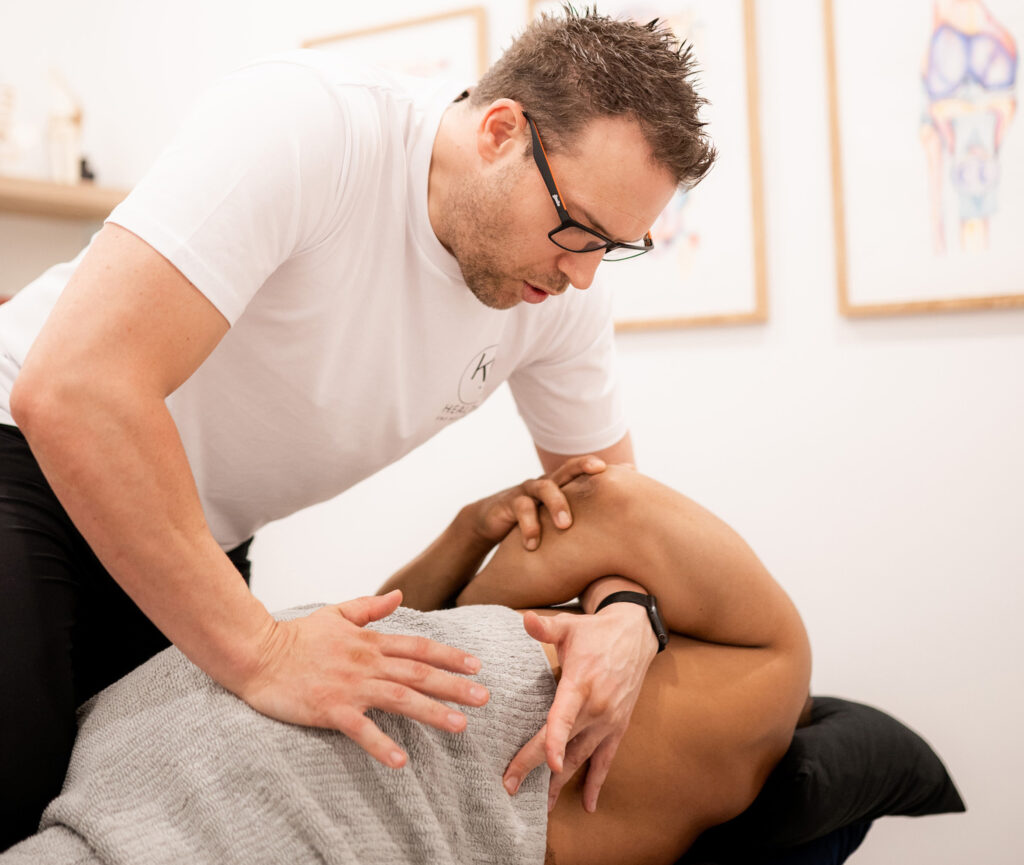Sacroiliac joint dysfunction happens when the SI joint, which connects your spine to your pelvis, becomes irritated, inflamed, or moves abnormally. The joint is meant to allow just a small amount of movement for shock absorption and stability. When it becomes too stiff or too loose, it can lead to lower back pain, pelvic pain, and sometimes referred pain into the buttock or leg.
An analogy…
Think of the SI joint like a hinge on a door, if it’s too tight or too loose, the door won’t open or close properly, and things start to strain. That’s what happens when the SI joint isn’t moving the way it should.
What are other names that sacroiliac joint dysfunction can be called?
Sacroiliac Joint Pain, Sacroiliac Joint Sprain, SIJ Dysfunction, Sacroiliac Joint Inflammation, Sacroiliac Joint Injury, Sacroiliac Joint Disorder, Sacroiliitis, Sacroiliacitis
What causes sacroiliac joint dysfunction?
The SI joint sits between the sacrum (bottom of the spine) and the ilium (part of the pelvis). It’s held together by strong ligaments and muscles, and it transfers forces between the upper body and legs. Dysfunction occurs when there’s either too much movement (hypermobility) or too little movement (hypomobility) in the joint. This can irritate the joint surfaces or surrounding tissues, leading to pain and dysfunction.
What are the signs and symptoms of sacroiliac joint dysfunction?
- Pain on one or both sides of the lower back, usually near the PSIS
- Pain that may refer into the buttock, hip, groin, or back of the thigh
- Stiffness or discomfort when standing, walking, or climbing stairs
- Pain with prolonged sitting, standing, or transitioning between positions
- A feeling of instability or “locking” in the pelvis
- Often worsens with activities like bending, twisting, or running
What tests are used to diagnose sacroiliac joint dysfunction?
FABER Test (Flexion, Abduction, External Rotation): The practitioner places the patient’s leg in a figure-4 position (ankle on opposite knee) and gently presses down on the bent knee while stabilising the opposite hip.
Gaenslen’s Test: The patient lies on their back or side with one leg pulled up to the chest and the other leg extended off the edge of the table. The practitioner applies pressure to both legs to stress the SI joints.
How long does sacroiliac joint dysfunction take to heal?
Recovery from sacroiliac joint dysfunction depends on how long the symptoms have been present, the underlying cause, and how quickly treatment begins. Mild cases can improve within 2 to 4 weeks with manual therapy and targeted exercise. More persistent cases may take 6 to 12 weeks or longer to fully resolve. Chronic or unstable cases may require ongoing management to help prevent flare-ups and maintain stability.
How does sacroiliac joint dysfunction happen?
- Prolonged sitting or standing
- Uneven or excessive weight bearing, such as carrying a baby on one hip or wearing high heels
- Pregnancy or postpartum changes (due to hormone-related ligament laxity)
- Pelvic imbalances, leg length differences, or poor biomechanics
- Falls, trauma, or lifting injuries
- Weak glutes and core muscles, leading to poor pelvic stability
What treatment can help sacroiliac joint dysfunction?
- Manual therapy (mobilisation or manipulation of the SI joint)
- Soft tissue release of surrounding tight muscles
- Exercise therapy to improve core and glute strength
- SI joint taping or belt to support the joint if it’s too mobile
- Posture and movement retraining for lifting, walking, and sitting
What exercises or stretches can I do for sacroiliac joint dysfunction?
- Pelvic tilts and core activation (CAZ) to stabilise the lumbar spine
- Glute bridges, clamshells, and resistance band work to strengthen the hips
- Gentle mobility work like cat-cow or hip openers
- Hip flexor and hamstring stretches
- Posture training and walking drills
- Controlled return to lifting, sport, or work movements
What products can help with sacroiliac joint dysfunction?






